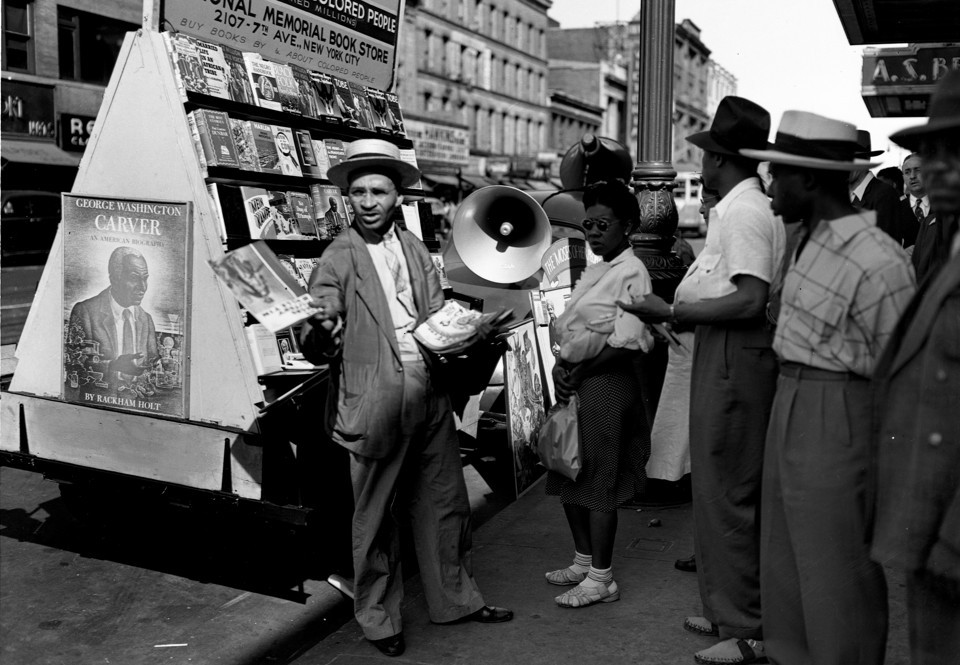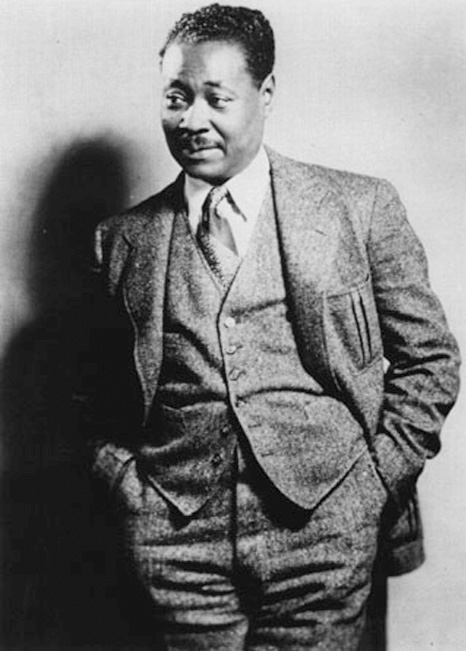A Forgotten Novel
Reveals a
Forgotten Harlem
Discovered 70 years after it was written,
Claude McKay’s Amiable With Big Teeth
depicts an overlooked time
in African American history when
communism and black nationalism
found themselves entangled.
Harlem Shadows, a landmark book of poetry that helped usher
in the Harlem Renaissance. Though McKay was a literary celebrity
in the New York neighborhood, his life and art were in many ways
defined by a kind of nomadism. His interest in both black
diasporas and communism led him to the waterfronts of Marseille
and Morocco, and to Moscow. It’s this experience that eventually
led McKay to write his newly discovered novel Amiable With Big
Teeth, which takes on the tensions between black nationalism and
more globally minded approaches to solidarity that reached a
fever pitch in the 1930s.
revolves around the Second Italo-Ethiopian War, in which Benito
Mussolini’s troops invaded, and went on to occupy, Ethiopia in
the mid-1930s. Watching from across the Atlantic, many African
Americans saw Italy’s military campaign as a direct attack on black
sovereignty by a white imperial power. But some communist
sympathizers in the U.S., most of whom were white, tried to
reframe the conflict as not being about race at all. They believed
it was instead about the rising threat of global fascism and urged
black Americans to align themselves with left-wing movements
abroad and with the Soviet Union.
This debate about the value of communist internationalism over black nationalism is at the core of Amiable With Big Teeth. Written at a time when most scholars thought that black cultural production had come to a grinding halt as a result of the Great Depression (and the consequent dip in arts patronage), Amiable With Big Teeth provides unparalleled insight into this relatively understudied moment in black American history. But the novel, and the picture of Harlem political culture it offers, came dangerously close to being lost to history altogether. Written in 1941, it was only unearthed in 2009 when a graduate student named Jean-Christophe Cloutier came across the manuscript by accident while doing research at Columbia University. Now an assistant professor of English at the University of Pennsylvania, Cloutier told me that he could assure readers “it was worth the wait.”
What excites Cloutier about Amiable With Big Teeth is that, despite its focus on global political intrigue, the story operates at a surprisingly compact and hyper-local scale. At its core, McKay’s text is essentially about fundraising: The novel revolves around a fictional black-led charity called Hands to Ethiopia that’s looking to raise money to supply Ethiopian soldiers with more weapons to defend themselves against Mussolini’s troops. Some of the familiar haunts of Harlem Renaissance literature are present—nightclubs, brownstones, and black society parties. But most of the drama of Amiable With Big Teeth unfolds in settings more evocative of community organizing than of the lives of uptown literati—in places like church basements, living rooms, and the cramped and chaotic offices of a non-profit.
complicated when a mysterious Russian interlocutor named
Maxim Tasan enters the picture. A black member of the charity
essentially becomes Tasan’s mole and encourages the organization
to open itself to white members and to expel Trotskyites. At the
time, the Russian Communist Leon Trotsky was living in Mexico
City to avoid political payback from Stalin; after challenging
Stalin’s rise to head of the Bolshevik Party, Trotsky was perceived
by many Communist stalwarts to be a traitor who had made the
party vulnerable to fractious dissent. But to the humble leader of
Hands to Ethiopia, a fascinating character by the name of Pablo
Peixota (an Afro-Brazilian turned Harlem numbers-runner), this
anti-Trotskyite campaign is an over-complication of what is
essentially a matter of race. For Peixota, the so-called “Italo-
Abyssinian crisis” is about “one little black nation, single-handed,
almost unarmed, fighting against a mighty white nation.”
Brent Hayes Edwards, a professor of English and comparative literature at Columbia University, who co-edited the manuscript with Cloutier, told me the global dimensions of Amiable With Big Teeth are in many ways a response to how World War I shaped black American consciousness. African American servicemen returned from abroad with a newfound “international viewpoint,” Edwards said. That global outlook motivated black Americans to become increasingly involved in the issues facing people of African descent worldwide. Of particular focus for black Americans was defending independent black nation-states—countries like Haiti, Liberia, and Ethiopia—from white Euro-American occupation. As Edwards explained, black sovereignty, or “the idea of black people defining their own destinies,” was “a big deal” at the time McKay was writing Amiable With Big Teeth.
In the introduction to the novel, Cloutier and Edwards quote McKay’s 1940 anthropological work, Harlem: Negro Metropolis, in which McKay explains the anxieties that animate much of the story: “Harlem [in the late 1930s] was overrun with white communists who promoted themselves as the only leader of the Negroes. They were converting a few Negroes into Bolshevik propagandists, but they were actually doing nothing to help alleviate the social misery of the Negroes.” McKay is referring to Soviet Russia’s propaganda campaign against the United States, which, during the Cold War, was partially directed toward exposing the nature of race relations in America. For instance, the Soviet press extensively covered the case of the Scottsboro Boys, and the Bolsheviks even sent money to aid in their legal defense.
Still, many African Americans, even those who believed in the economic principles of communism, were suspicious of whether the Soviets fully grasped the intricacies of race in the United States. As the author Zora Neale Hurston once put it, “What the hen-fire could Russia do for us?” This skepticism manifests in Amiable With Big Teeth when Maxim Tasan tries to convert Pablo Peixota’s daughter, Seraphine, to his cause by telling her that Russians don’t believe in race. He cites the fame of Alexander Pushkin, often called the father of Russian literature, whose maternal great-grandfather was from Eritrea (though Tasan says Ethiopia and indeed, this fact is disputed between the two countries) as proof of Soviet Russia’s legacy of color-blindness. When Tasan proudly tells Seraphine that Pushkin’s descendants were known as “Russians, not Russafricans,” she can’t help but interpret what they’re doing as “passing”—pretending not to be black and thus shamefully denying their heritage. The scene speaks to the friction and misunderstandings that McKay and Hurston believed plagued Soviet messaging on race relations.
McKay’s critique of Russian communism was especially noteworthy given his earlier commitment to the Soviet cause. In 1922, McKay spoke as an unofficial representative of the “American Negro” at the Fourth Congress of the Communist International in Moscow, which also coincided with the fifth anniversary of the Russian Revolution. He wrote about his experiences in a 1923 issue of the NAACP magazine The Crisis, in an essay titled “Soviet Russia and the Negro.” In Moscow, he spoke with hopefulness about the Soviet Union’s potential to serve as a global beacon for racial equality, citing Russia’s own racial makeup as a country whose geopolitical position created a nation “where all the races of Europe and Asia meet and mix.” McKay’s eventual disillusionment with the Soviet Union is well documented in his personal correspondence, but Amiable With Big Teeth represents a thorough artistic rendering of black disappointment with Soviet communism.
For a work so rooted in international politics and full of non-American characters, Amiable With Big Teeth has the surprising distinction of being the only novel McKay ever wrote on American soil. (He toiled away on it while holed up in a cabin in Maine, “up here where it is cold and bracing,” he told a friend.) Despite his centrality to the Harlem Renaissance, McKay spent much of the period when that movement flourished abroad, in Western Europe, Morocco, and, of course, in Moscow. McKay’s contribution to the Harlem Renaissance was his decidedly global pan-African outlook.
written in Jamaican patois) to his 1929 novel Banjo, which chronicled
the lives of Senegalese dock workers in Marseille, McKay’s oeuvre
captured a multi-lingual black diaspora interested in forging a global
identity beyond the “Back to Africa” nationalist rhetoric of Marcus
Garvey (whose followers are satirized in Amiable With Big Teeth). In
that regard, Amiable With Big Teeth is typical of McKay’s writing
style, which was conversational in nature, and conveyed obsession
through dialogue and debate. According to Edwards, McKay’s novels
were “less about psychological interiority and more about … black
people from around the world arguing about what they have in
common.”As a creative work and a historical document, Amiable
With Big Teeth is nothing short of a master key into a world where
the intersection of race and global revolutionary politics plays out in
the lives of characters who are as dynamic and fully realized as the
novel itself. The story offers a front-row seat to the polemics that
drove (and stymied) black radical organizing in the 1930s. Given that
the novel lived on the dusty shelves of Columbia University’s library
for decades, we’ll never know how Amiable With Big Teeth would
have been received at the time it was written, and if its skepticism
regarding Russia would have complicated the reception of Richard
Wright’s pro-communist 1940 novel Native Son. But for today’s
audience, McKay’s last novel should make for fascinating and timely
reading as Americans enter an era in which solidarity-building
across racial identities and national borders feels more necessary,
and perhaps more difficult to achieve, than ever.



